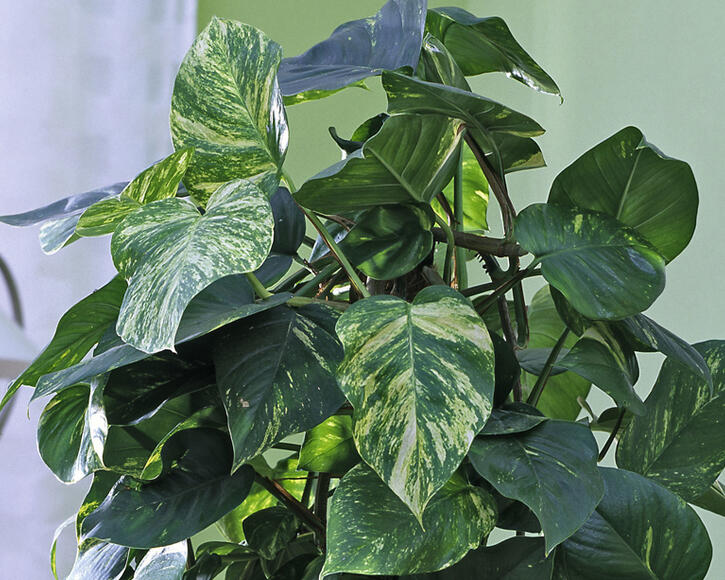Dragon-tail plant
Whether hanging or climbing: The undemanding Dragon-tail plant is the perfect green plant to beautify indoor areas. Here’s how to plant and care for them.
Factsheet
- Growth type
-
- Climber
- Perennial plant
- Growth height (from)
- from 50 cm to 200 cm
- Growth characteristics
-
- overhanging
- Flower color
-
- green
- white
- Flower shape
-
- Pistons
- Flower characteristics
-
- unimpressive
- Leaf color
-
- green
- page format
-
- full margined
- heart-shaped
- pointed
- Sheet properties
-
- evergreen
- Light
-
- scattered light to semi-shade
- Soil Moisture
-
- moderately humid
- Nutrient requirements
-
- nutrient-rich
- Humus
-
- rich in humus
- Decorative or utility value
-
- Leaf ornaments
- Toxicity
-
- toxic
- Use
-
- Interior greening
- Winter garden
- Garden style
-
- Pot garden
The Dragon-tail plant (Epipremnum pinnatum) is a climbing and ornamental plant and belongs to the Araceae botanical family. Its native origin is south-east Asia, Australia and the Pacific islands, where it grows wild. It is popularly cultivated in our climate as a house and office plant, or also as a bedroom plant.
The evergreen dragon-tail plant is a persistent, herbaceous grower. As a climbing plant, the dragon-tail plant grows shoots up to 32.81 feet long, with the proper care. This makes it perfect both as a hanging basket plant, and as an overhanging indoor plant, creating greenery for room dividers, bannisters or walls in conservatories. It is often available as a potted plant growing upwards on a moss rod.
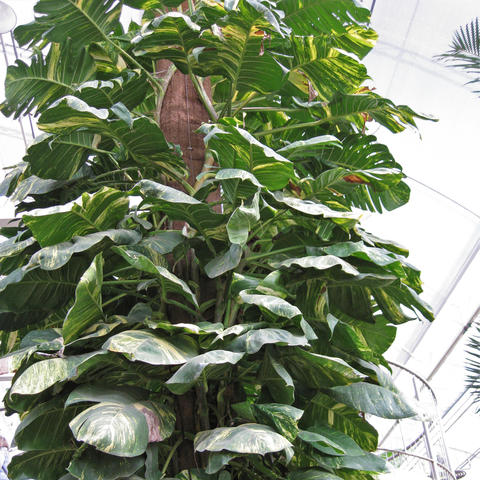
Whoa, doppelganger! The dragon-tail plant (Epipremnum pinnatum) is often confused with its relative, the satin pothos (Scindapsus pictus, also Epipremnum pictum ‘Argyraeum’). However, unlike the Epipremnum pinnatum, the satin pothos has clearly silvery foliage with white dots. Still, these sisters do have very similar care requirements.
The leathery leaves of the dragon-tail plant are cordate and located alternately on short stalks. The younger leaves are more symmetrical than the older ones. They often have a flecked or striped pattern in white, creme, or yellow. The basic color of the leaves also extends across various strong green tones. Caution: The Dragon-tail plant leaves contain calcium oxalate, which irritates skin and mucous membranes and should therefore never be consumed!
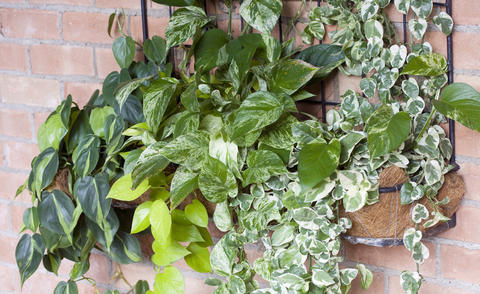
The Dragon-tail does not normally flower as a houseplant. This is because the Eprimemnum genus only flowers after the formation of the very large (in the wild up to 3.28 foot), perforated older leaves, which doesn’t normally happen in indoor cultivation. In their tropical home, the dragon-tail plant flowers on an inconspicuous green-white cylindrical spadix.
At our latitudes, the dragon-tail plant is a non-winter hardy, full-flowering houseplant and should be kept warm at around 68 degrees Fahrenheit, and never be placed in temperatures below 61 degrees Fahrenheit in the winter. A bright to semi-shady location out of drafts and direct sunlight is ideal, although varieties with dark foliage are suited to darker spaces in the center of the room or in stairways. However, the darker the location of the dragon-tail plant, the less striking its leaf markings. Dragon-tail varieties with colorful foliage should therefore be positioned closer to the window. The dragon-tail plant can be grown either as a climber or a hanging basket plant. When it is placed in a hanging basket, the dragon-tail plant weaves a dense curtain. With a little skill, it can be turned into an excellent room divider. However, the dragon-tail plant also cuts an elegant figure on cupboards, wall shelves, and racks. As Epipremnum values high levels of humidity, it is also happy in the bathroom. Standard potting soil is a suitable substrate, however dragon-tail plants also grow well in hydroponic cultivation.
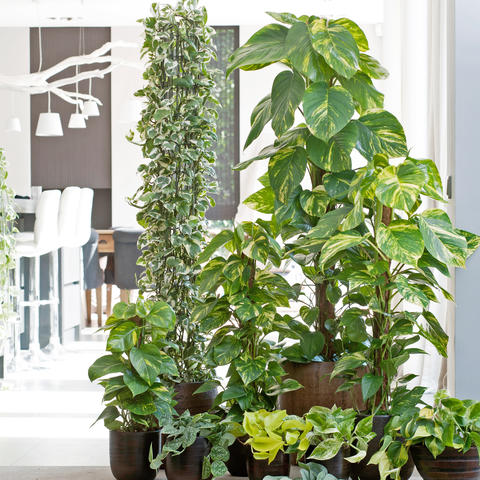
Dragon-tail plants are extremely frugal where water supply is concerned. Ideally, they should be kept evenly moist. However, Dragon-tail plants also forgive temporary dryness or longer watering intervals, so they are perfect for those who travel more frequently or forget their plants from time to time. Their water requirements drop in the winter and they should be watered less. Hanging baskets should have a plant saucer or be water tight to prevent water dripping onto the ground. Water carefully and shake off standing water if necessary, as dragon-tail plants do not tolerate waterlogging. If the plant is kept too wet permanently, the roots will rot and this otherwise robust plant will succumb. Well rooted plants can also be watered directly in the plant saucer. Any spray from the watering can increases the humidity and reduces the risk of spider mite infestation.
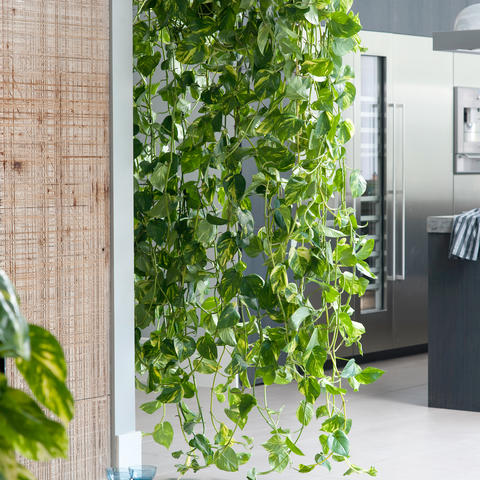
Although the Dragon-tail plant is an extremely easycare houseplant that can cope without fertilizer, for the best care it should be given a foliate plant fertilizer every week to 14 days during the growth phase from March until August.
The dragon-tail plant can be repotted every two years if the pot has become too small. This is not essential. When repotting, the old soil should be completely shaken off the roots and the root tips slightly trimmed. The tendrils can be pruned at any time and this does not harm the plant. The Dragon-tail plant branches off better if the shoots are clipped.
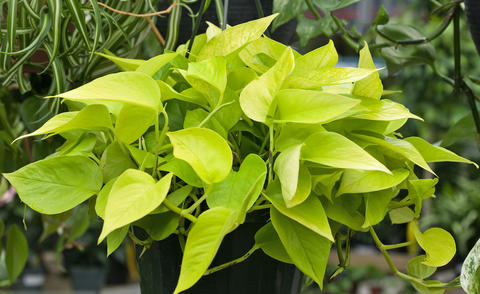
The ‘Aureum’ variety, also known as "Golden Pothos”, is widespread and has apple-green leaves in a pretty, cordate shape with a beige or golden variegation. The variety ‘Marble Queen’ also has light green and white piebald foliage. It is almost indestructible and grows in any dark room corner. The variegation on ‘Golden Queen’ covers large areas and is golden-yellow. Epipremnum ‘N-Joy’ has green leaves with a large amount of white, the variety ‘Wilcoxii’ has a yellow foliage pattern. It reacts with somewhat more sensitivity to its location conditions than other varieties. Caution: As the Dragon-tail plant foliage markings react strongly to the light conditions available, the varieties may have considerably different coloring depending on their location!
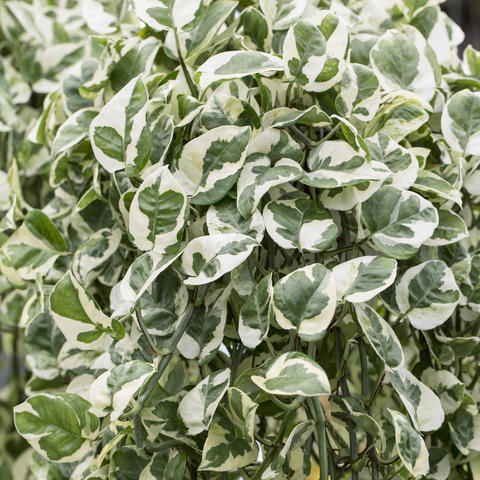
Dragon-tail plants are incredibly simple to propagate, as both head and shoot cuttings readily form shoots in a water glass. The climbing plant is so undemanding that it can even be propagated in January. You can do this by cutting off individual shoots and placing them in a water glass in such a way that a knot is always in the water, as this is where the majority of the roots form. The cuttings can be planted when the roots are about 0.79 inches long. For a beautiful, dense plant, it is best to place several cuttings in one pot, as dragon-tail plants do not form side shoots. Alternatively, offsets can also be grown directly in the soil or in hydroponic cultivation. Simply submerge the aerial roots in pots filled with soil or expanding clay that are positioned next to the mother plant. When the little plants have plenty of new leaves, indicating that they have taken root, separate them from the mother plant.
Foliage droppage and root rot are a threat in conditions which are too wet or dark. Spotty or withered leaves could indicate a location that is too drafty. In the event of a pest infestation, it is best to thoroughly wash the plant off under the shower and then treat it with a spray.
Dragon-tail plants remove poisonous substances from the air. This makes them particularly resistant to cigarette smoke and exhaust fumes. Thus, Dragon-tail plants are able to absorb so much nicotine from the room air that the concentration in their leaves afterwards is three times higher than in a real tobacco plant! Moreover, the green plant filters formaldehyde out of varnishes and paint coatings on furniture and reduces the carbon dioxide content in the air. This makes the Epipremnum a veritable air freshener. However, a large number of plants are required for a measurable improvement in the room climate. Caution: Due to the retention of large amounts of harmful substances, dragon-tail plants should be disposed of in the household waste at the end of their lives and not in the compost.

